Benefits of tailored parenteral nutrition
Parenteral nutrition (PN) is a vital intervention in modern healthcare, especially for patients who cannot meet their nutritional needs through oral or enteral routes. While standardized PN solutions offer convenience and efficiency, personalized approach to PN formulation ensures that individual patient needs are precisely met, leading to better clinical outcomes and minimized complications. This article explores the multifaceted benefits of tailored parenteral nutrition, including its application in diverse clinical scenarios, supported by current research and clinical guidelines.
The Importance of Customization in Parenteral Nutrition
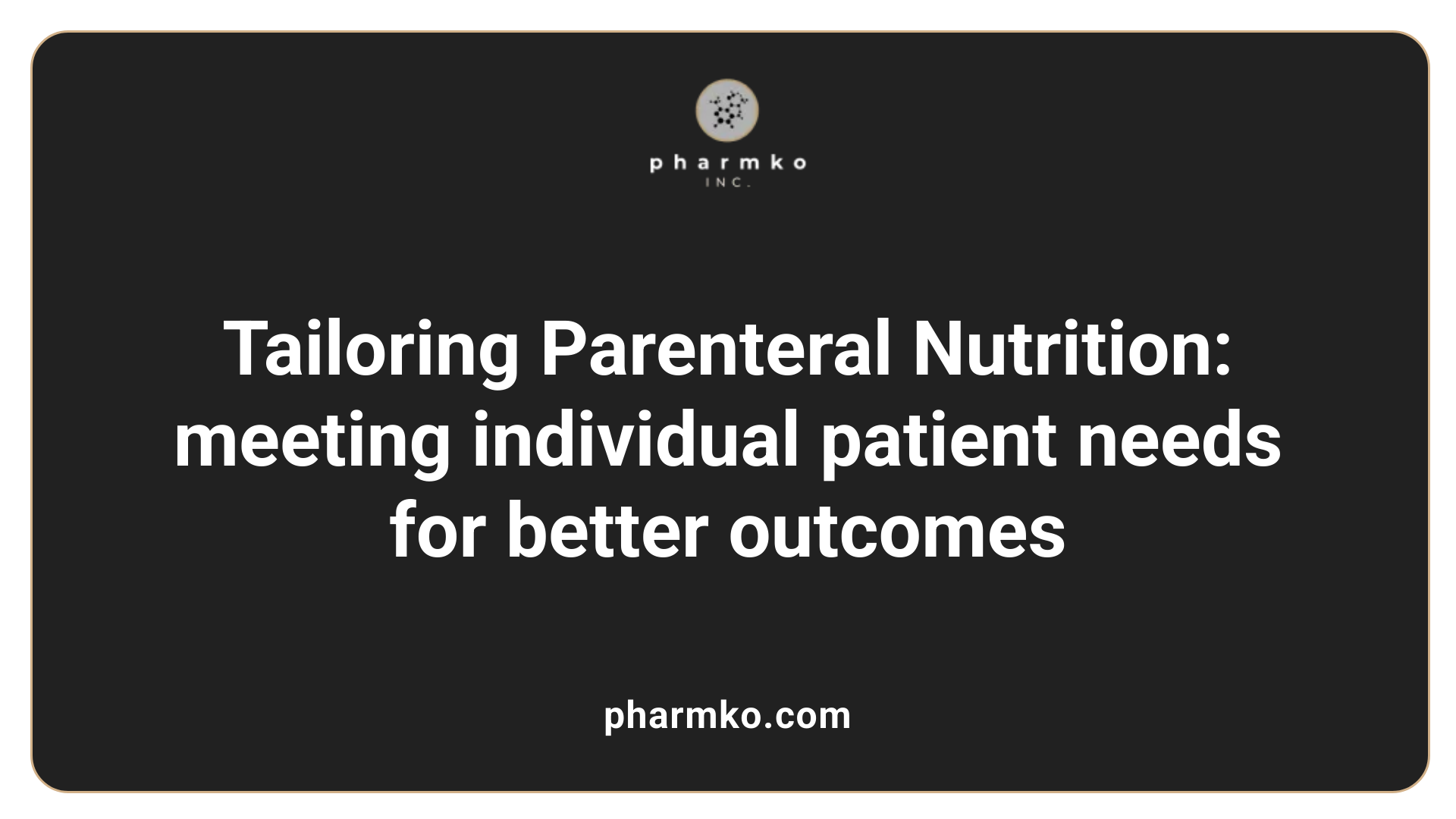
Why is customization important in parenteral nutrition formulations?
Personalized parenteral nutrition (PN) formulations are vital because they are tailored to meet the unique nutritional needs of each patient. Patients vary widely based on their age, disease, organ function, and nutritional status. For instance, a neonate with a fragile immune system or a patient with liver dysfunction requires different nutrient compositions compared to a healthy adult.
Individualized PN ensures that each patient receives the correct balance of macronutrients—proteins, carbohydrates, and fats—as well as essential micronutrients like vitamins and trace elements. This customization helps optimize recovery, growth, and overall health while reducing the risk of complications such as electrolyte imbalances, hyperglycemia, or nutrient deficiencies.
Although standardized PN solutions—produced in ready-to-use multi-chamber bags—are practical and reduce preparation errors, they may not always suit complex or special cases. Customized PN allows healthcare providers to make adjustments based on laboratory results and ongoing assessments, ensuring optimal nutrient delivery tailored to the patient's evolving clinical needs.
This approach not only improves treatment efficacy but also minimizes metabolic disturbances and reduces the chance of infections related to improper nutrient composition. In sum, customization in parenteral nutrition plays a crucial role in enhancing patient safety, supporting better clinical outcomes, and ensuring that nutritional therapy aligns with the specific therapeutic goals.
Clinical Benefits of Individualized Parenteral Nutrition
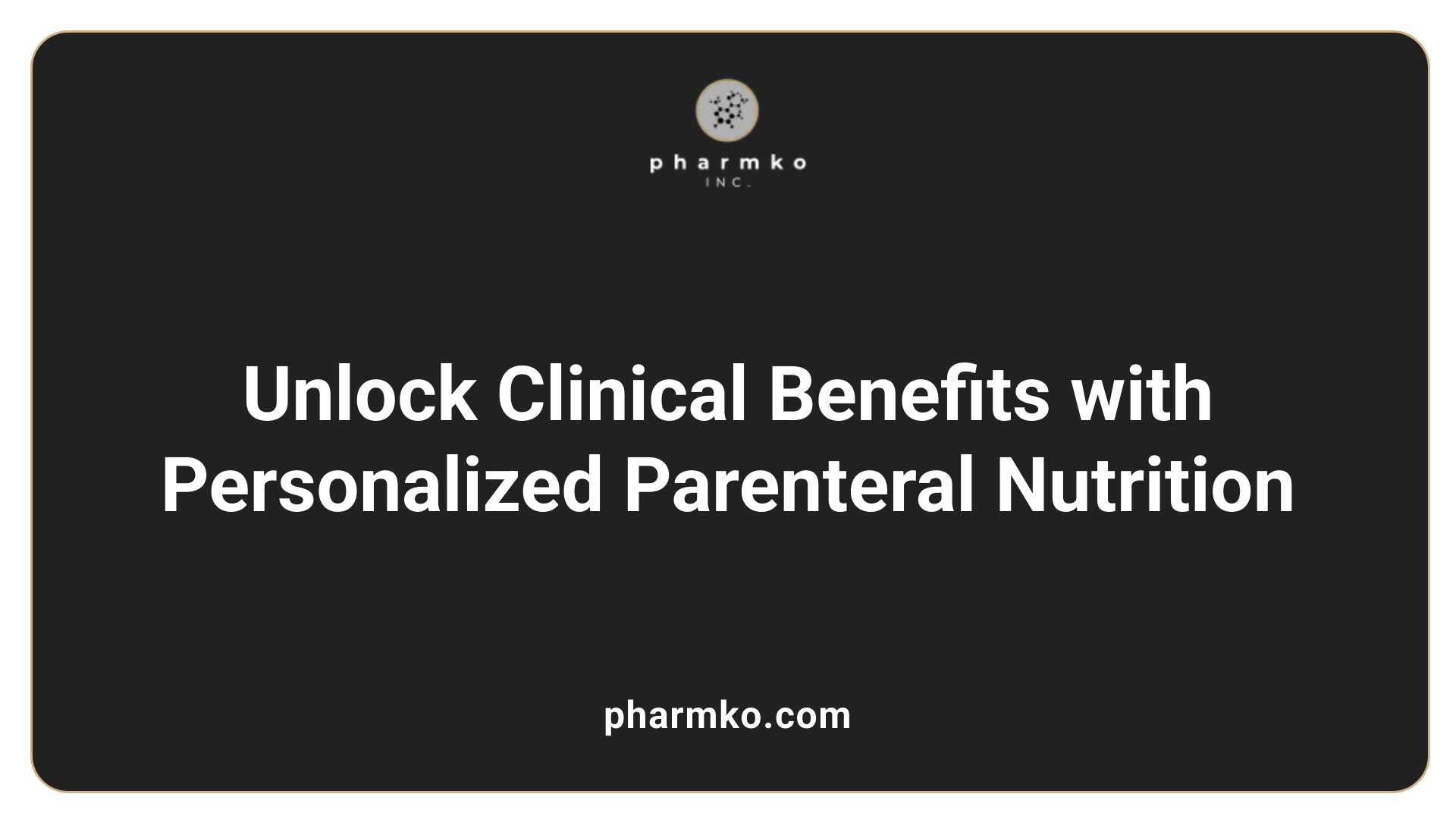 Parenteral nutrition (PN) offers several clinical advantages, especially when tailored to the specific needs of individual patients. Customizing nutritional support can significantly impact recovery and healing by ensuring that patients receive the right balance of nutrients, supporting tissue repair, immune function, and overall growth.
Parenteral nutrition (PN) offers several clinical advantages, especially when tailored to the specific needs of individual patients. Customizing nutritional support can significantly impact recovery and healing by ensuring that patients receive the right balance of nutrients, supporting tissue repair, immune function, and overall growth.
Patients with complex medical conditions such as gastrointestinal dysfunction, post-surgical recovery, or critical illnesses benefit from nutrient formulations adjusted to their unique metabolic demands. For example, in cases with impaired gut function, personalized PN helps prevent malnutrition and supports healing while bypassing affected digestive pathways.
Additionally, closely monitored, tailored PN reduces risks of metabolic disturbances such as hyperglycemia, electrolyte imbalances, and fatty liver disease. By precisely regulating the composition and infusion rates, healthcare providers optimize treatment effectiveness and minimize potential complications.
Overall, individualized PN plays a vital role in improving health outcomes, aiding recovery, and fostering better management of complex conditions. Continuous advancements, including the use of biomarkers and digital tools, enhance our ability to design precise nutritional interventions suited for each patient’s unique needs.
Role of Tailored Parenteral Nutrition in Critical and Hospital Settings
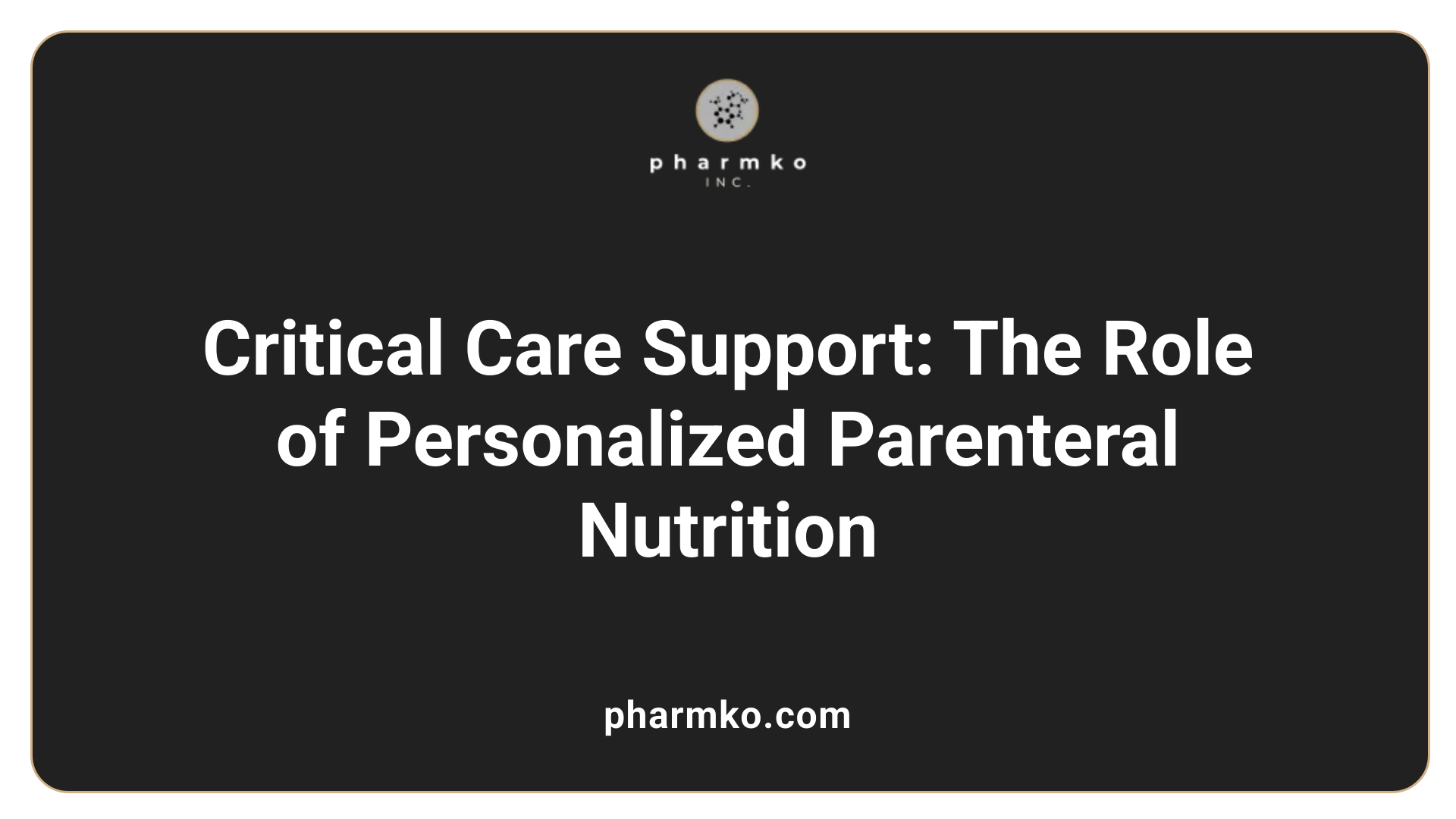
What is the role of tailored parenteral nutrition in critical and hospital settings?
Tailored parenteral nutrition (PN) plays a vital role in hospitals by providing individualized nutritional support to patients who cannot intake nutrients orally or through the digestive tract effectively. This includes patients with gastrointestinal failure, severe illnesses, or those recovering from major surgery.
In critical care, customized PN ensures that each patient's specific needs for energy, proteins, lipids, vitamins, and minerals are met securely through intravenous administration. Proper formulation considers the patient's condition, weight, age, and metabolic demands.
Ensuring safe delivery involves meticulous planning, appropriate vascular access, and ongoing monitoring. Adjustments are made based on blood tests and clinical status to minimize risks such as infections, metabolic imbalances, and liver complications.
When correctly managed, tailored PN can prevent malnutrition, support tissue repair, and enhance overall recovery. It reduces the likelihood of deterioration linked to nutritional deficits and helps maintain the patient's functional status during prolonged hospital stays.
Overall, the main purpose of personalized PN in hospital and critical care settings is to provide a safe, effective, and individualized nutritional solution. By doing so, it significantly improves outcomes for vulnerable patient populations, especially those unable to absorb or tolerate enteral nutrition. This carefully prescribed therapy supports recovery, optimizes physiological functions, and mitigates potential complications associated with malnutrition.
Advances and Strategies in Parenteral Nutrition Formulation
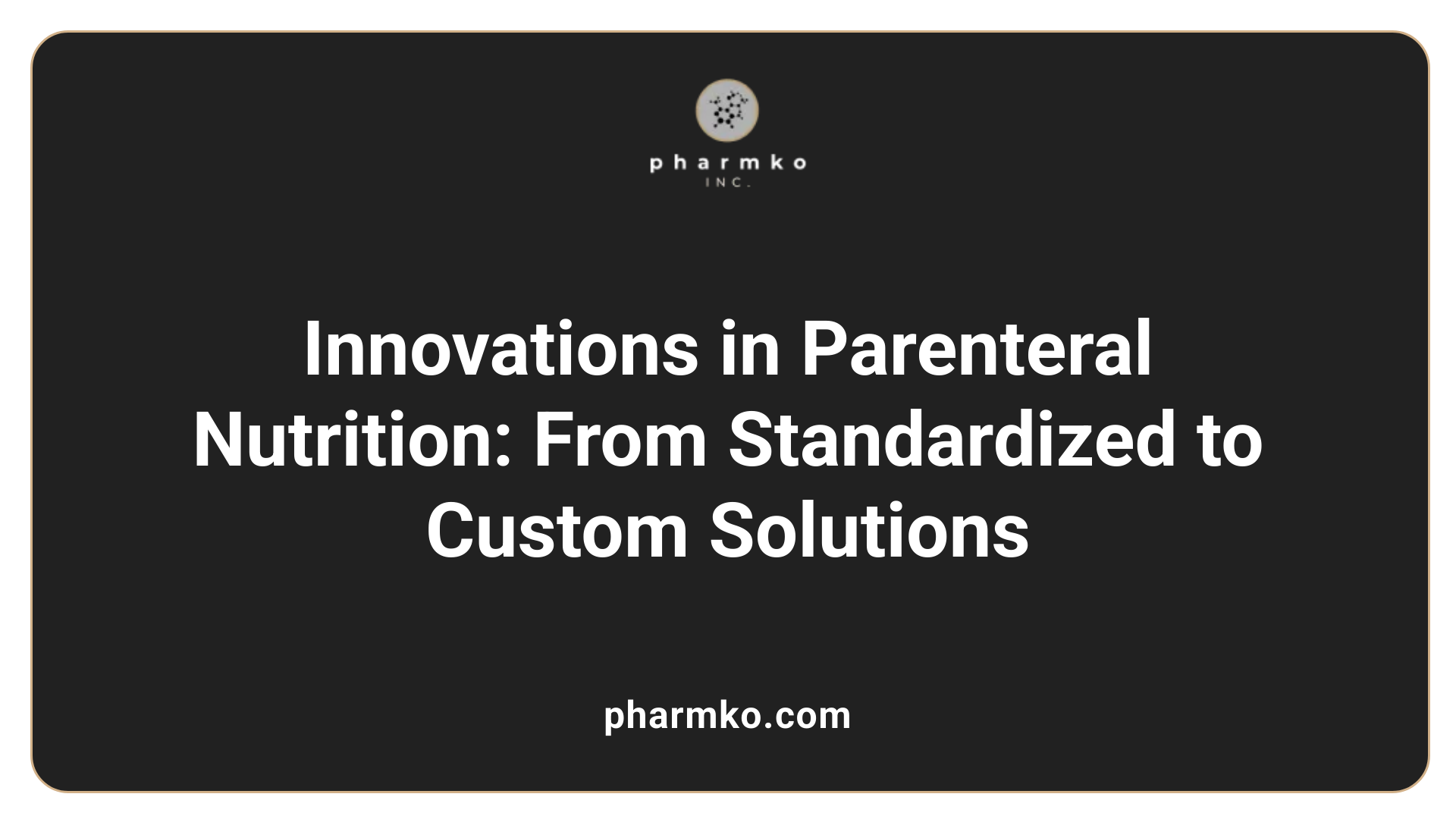 Parenteral nutrition (PN) has evolved significantly with the development of both standardized and customized formulations. These approaches aim to optimize nutritional support for various patient populations, from preterm infants to critically ill adults.
Parenteral nutrition (PN) has evolved significantly with the development of both standardized and customized formulations. These approaches aim to optimize nutritional support for various patient populations, from preterm infants to critically ill adults.
Standardized PN solutions, often delivered as multi-chamber bags, are designed to meet the typical nutritional needs of specific age groups or clinical conditions. These ready-to-use solutions offer several advantages, including improved safety, ease of preparation, longer shelf life, and faster initiation of therapy. Multi-chamber bags from manufacturers like Baxter provide pre-dosed nutrients—such as amino acids, dextrose, lipids, and micronutrients—that are balanced for neonatal, pediatric, or adult patients, reducing handling errors and contamination risks.
In contrast, customized or compounded PN involves preparing nutrient mixtures tailored to the individual patient’s needs. This process often occurs in hospital pharmacies and allows for adjustments in nutrient concentrations and specific additives, such as electrolytes or vitamins, based on blood work and clinical parameters. While personalized PN can address unique metabolic requirements, it requires rigorous quality control, strict aseptic techniques, and precise compounding procedures to ensure safety.
Technology and Safety Measures
Advances in technology, including computer-assisted prescribing systems, have enhanced the safety and accuracy of PN therapy. These systems assist clinicians in calculating and verifying nutrient compositions, reducing errors and streamlining the process.
Quality assurance and proper storage are critical, especially for compounded solutions. The use of two-chamber or three-chamber bags has gained popularity because they simplify preparation and minimize incompatibility issues. The stability of these solutions relies on correct storage conditions, often in refrigerated environments, while ensuring compatibility among the different components.
Individualized vs. Standardized Approaches
Current evidence indicates that standardized PN can promote early weight gain, growth, and higher nutrient intake in preterm and very-low-birth-weight infants. Several studies suggest that standardized solutions may reduce the duration of PN, electrolyte disturbances, and even the risk of infections related to handling and preparation. These benefits make SPN an attractive choice in many settings.
However, individualized PN remains essential when patients present specific metabolic needs or complex clinical scenarios that standard formulas cannot accommodate. The decision to use standardized or tailored PN depends on the patient's condition, institutional protocols, and available resources.
| Aspect | Standardized PN | Customized PN | Additional Notes |
|---|---|---|---|
| Preparation | Pre-made, multi-chamber bags | Compounded in pharmacy | Requires sterile technique |
| Flexibility | Limited to predefined formulations | Fully adjustable | Better for complex needs |
| Safety | Reduced error risk | Higher risk if improper | Enhanced with technology |
| Use cases | Neonates, stable patients | Patients with specific metabolic needs | Clinical judgment essential |
In summary, both approaches serve vital roles in clinical practice. The integration of technological advances and rigorous safety protocols continues to enhance the effectiveness and safety of parenteral nutrition, ensuring optimal patient care.
The Role of Micronutrients and Lipid Emulsions in PN
Why is customization important in parenteral nutrition formulations?
Customization plays a vital role in parenteral nutrition (PN) because every patient has unique nutritional needs based on their health status, disease process, and organ functionality. Tailoring PN formulations allows healthcare providers to balance macro- and micronutrients precisely, ensuring optimal recovery and minimizing risks.
Standardized PN solutions, while convenient and resource-efficient, may not meet the specific demands of individual patients. For example, some patients might require higher protein doses due to catabolic states, or specific micronutrients to correct deficiencies. Personalized PN approaches enable adjustments based on ongoing laboratory assessments, such as electrolyte levels, liver function tests, and serum nutrient concentrations.
By customizing PN, clinicians can improve outcomes such as immune function, wound healing, and overall nutritional status. It also reduces potential complications like electrolyte imbalances, hyperglycemia, or nutrient deficiencies. This tailored approach supports recovery, prevents adverse effects, and aligns treatment with each patient's clinical goals.
The importance of individualized PN formulations is underscored by advances in nutritional science, which recognize the influence of lipid profiles and micronutrient balance on inflammation, immune response, and hepatic health. Proper customization ensures that lipids provide essential fatty acids without exacerbating inflammation or liver stress, and that micronutrients support metabolic needs—ultimately leading to safer, more effective nutritional therapy.
The Development and Use of Multi-Chamber and Ready-to-Use PN Solutions
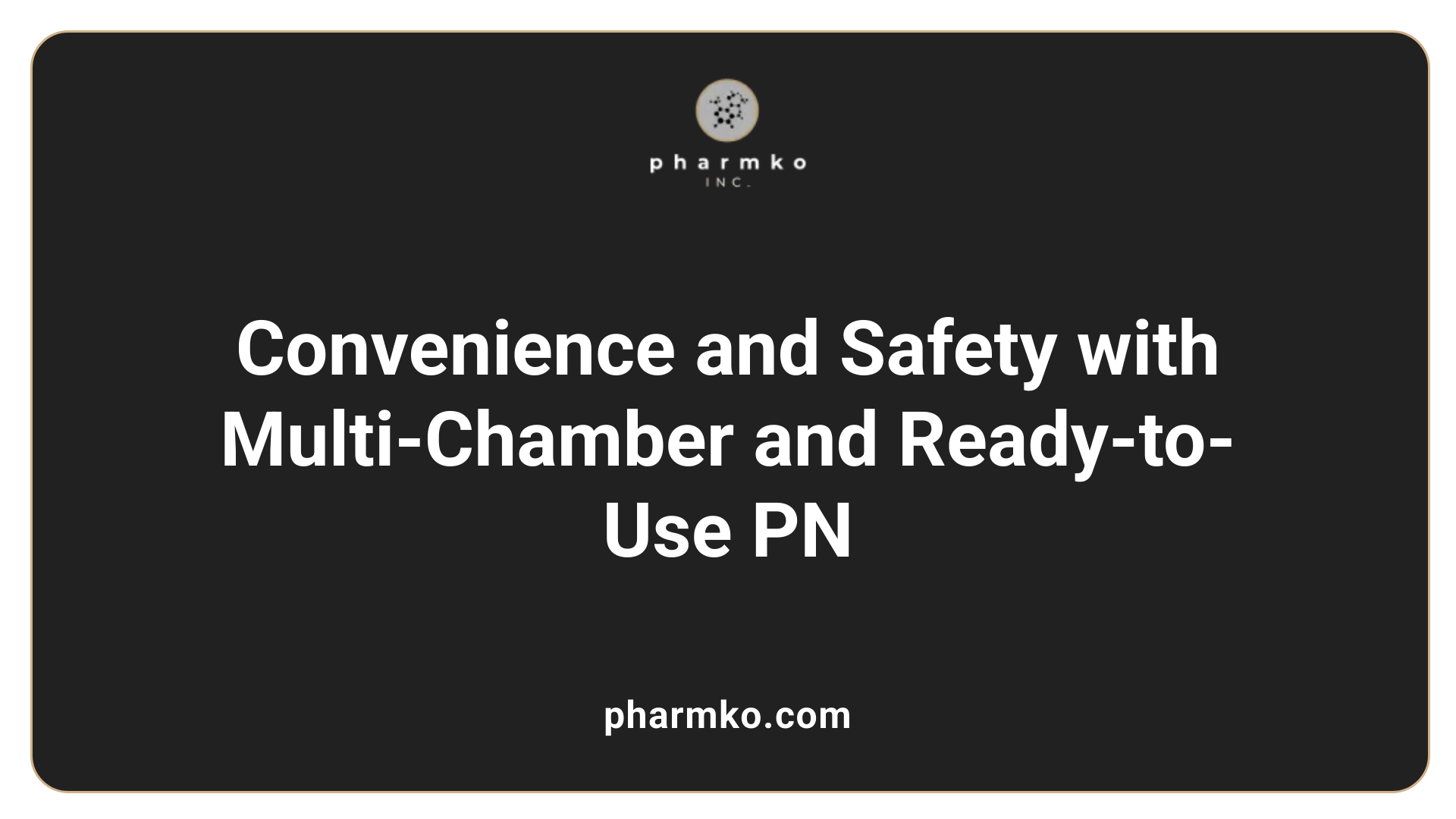
What are the advantages and clinical benefits of personalized parenteral nutrition approaches?
Personalized parenteral nutrition (PN) is designed to meet the specific nutritional needs of individual patients. This tailored approach improves recovery by ensuring each patient receives the right balance of nutrients, electrolytes, and vitamins based on their unique health status and metabolic demands.
One of the primary benefits is the ability to correct biochemical imbalances precisely. This minimizes the risk of complications such as hyperglycemia, electrolyte disturbances, or deficiencies in essential nutrients. Personalized PN is especially valuable in complex cases like malnutrition, severe infections, or specific disease requirements.
Additionally, individualizing PN allows healthcare providers to adapt nutrient delivery based on ongoing monitoring of blood tests, energy expenditure, and muscle mass. This continuous assessment helps optimize nutritional support, supporting tissue repair, immune function, and overall recovery.
Furthermore, tailored PN can reduce the risk of long-term complications such as liver problems and bile duct issues that may arise from inappropriate nutrient formulations. By aligning treatment with the patient's evolving condition, personalized PN enhances safety and efficacy.
Ultimately, a patient-specific approach leads to improved clinical outcomes, shorter hospital stays, and better quality of life for patients unable to meet their nutritional needs through oral or enteral feeding.
Advantages of multi-chamber bags
Multi-chamber bags represent a significant advancement in PN therapy, offering convenience, safety, and standardization. These pre-mixed solutions contain separate compartments for different nutrients, such as amino acids, glucose, lipids, vitamins, and electrolytes. They are designed to be mixed just before administration, ensuring freshness and stability.
The multiple compartments allow for a balanced, properly proportioned nutritional solution that can be tailored to specific patient needs. This modular design reduces the need for manual preparation, decreasing the potential for errors and contamination. Multi-chamber bags also simplify inventory management and streamline hospital workflows.
Shelf-life and stability
One of the advantages of multi-chamber and ready-to-use PN solutions is their extended shelf-life, often exceeding 12 months when stored properly. This long stability period makes them highly suitable for hospital pharmacies, allowing for better stock management.
The stability of these solutions depends on factors like the type of nutrients, the presence of antioxidants, and storage conditions. Manufacturers rigorously test formulations to ensure compatibility and prevent nutrient degradation over time.
Proper storage, typically at controlled temperatures, preserves the nutrient integrity and prevents microbial growth. Their stability ensures that healthcare providers can administer PN promptly without compromising quality.
Preparation and handling
Ready-to-use PN solutions like multi-chamber bags are designed for ease of use. They bypass the complex and time-consuming manual compounding process, reducing preparation errors and potential contaminants.
Preparation involves simply inspecting the bag for integrity, verifying expiration dates, and ensuring proper storage conditions. Just before administration, the compartments are mixed using a built-in connector or via an infusion pump.
These solutions are often ready to be administered directly from the packaging, which enhances safety and efficiency in clinical settings. Handling protocols emphasize aseptic techniques to maintain sterility and avoid infections.
In conclusion, multi-chamber and ready-to-use PN solutions represent a significant improvement in parenteral nutrition therapy. Their advantages include safety, convenience, and prolonging shelf-life, making them invaluable tools for delivering effective nutritional support to vulnerable patients.
Supporting Evidence and Research on Personalized PN
What evidence supports the benefits of personalized parenteral nutrition?
Research and clinical trials consistently demonstrate that personalized parenteral nutrition (PN) significantly enhances patient outcomes by customizing nutrient delivery to meet individual needs. Tailored approaches often include measurements of energy expenditure using indirect calorimetry, allowing clinicians to set precise caloric targets that match the patient’s metabolic demands. This individualized planning helps prevent overfeeding or underfeeding, both of which can cause complications.
Early initiation of PN, generally within 48 hours when enteral nutrition isn't possible, has been shown to be both safe and beneficial. It aids in faster recovery, reduces muscle wasting, and minimizes infection risks. Monitoring key indicators such as serum electrolytes, blood glucose, and muscle mass—using tools like ultrasound or bioelectrical impedance analysis (BIA)—facilitates ongoing adjustments to the PN formulation. This ensures optimal balance of macronutrients and micronutrients, reducing potential metabolic disturbances.
Advancements in specialty nutrients and administration techniques further support tailored recovery goals. For example, selecting lipid emulsions rich in omega-3 fatty acids or adjusting amino acid profiles based on the patient's condition can optimize immune function and tissue repair.
Meta-analyses and systematic reviews have validated these benefits, highlighting that personalized PN improves clinical outcomes such as shortened hospital stays, reduced infections, and better maintenance of lean body mass. In critically ill or malnourished patients, this individualized approach is especially effective in supporting recovery, reducing complications, and enhancing overall health.
Overall, evidence continuously underscores that meticulous customization and careful monitoring in PN therapy are essential for maximizing benefits, minimizing risks, and ensuring the best possible patient results.
Safety, Monitoring, and Future Directions in Tailored PN
What are the safety and efficacy considerations of tailored parenteral nutrition?
Tailored parenteral nutrition (PN) offers personalized support by aligning nutrient delivery precisely with individual patient needs. This customization improves safety and effectiveness by ensuring the right balance of macronutrients, micronutrients, and electrolytes based on thorough assessments.
To minimize risks, healthcare providers use validated screening tools and leverage advanced technologies such as electronic health records (EHRs) and barcode medication administration systems. These tools help reduce errors in prescribing, compounding, and administering PN.
A multidisciplinary team—including dietitians, pharmacists, nurses, and physicians—closely monitors patients for potential complications. These include metabolic disturbances like hyperglycemia or electrolyte imbalances, infectious risks related to catheter use, and long-term issues such as hepatobiliary problems. Regular evaluations of clinical outcomes, nutritional adequacy, and quality of life guide necessary adjustments.
Effective communication among team members and patient education further enhances safety. Continuous vigilance and adherence to current guidelines ensure tailored PN delivers maximum benefit while minimizing adverse effects.
Monitoring strategies for parenteral nutrition
Monitoring is vital for safe and effective PN therapy. Key strategies include:
| Aspect | Actions | Purpose |
|---|---|---|
| Blood glucose levels | Frequent testing, especially during dose adjustments | Prevent hyperglycemia |
| Electrolyte and mineral panels | Regular serum electrolyte and mineral assessments | Detect imbalances early |
| Liver function tests | Periodic assessment of liver enzymes and bilirubin levels | Identify hepatobiliary complications early |
| Renal function | Monitoring serum creatinine and urea | Prevent renal overload or impairment |
| Infection surveillance | Strict aseptic technique and catheter site evaluations | Reduce bloodstream infection risk |
| Nutritional adequacy | Measuring intake/output, body weight, and clinical response | Ensure balanced nutrient delivery and adjust therapy |
In addition, imaging or liver ultrasounds may be utilized for long-term PN patients. Electronic prescribing and real-time monitoring systems help detect early signs of complications and allow timely interventions.
Future innovations and research in parenteral nutrition
Emerging research focuses on improving PN formulations and delivery methods. Innovations include:
- Smart delivery systems: Integration of sensors and automation to monitor and adjust nutrient infusion rates in real-time.
- Novel lipid emulsions: Development of lipid sources, such as fish oil-based emulsions, to reduce hepatotoxicity and inflammation.
- Personalized nutrition algorithms: Using genetic, metabolic, and microbiome data to tailor PN even more precisely.
- Improved stability and compatibility: Formulations that last longer and minimize incompatibility issues, simplifying preparation and reducing errors.
- Enhanced safety protocols: Adoption of machine learning and AI tools to predict and prevent complications proactively.
Research continues to address long-term effects like fatty liver disease and cholestasis, aiming to develop therapies that reduce these risks while optimizing nutritional status.
These advancements aim to make PN safer, more effective, and better suited to the evolving needs of diverse patient populations, ultimately improving outcomes and quality of life.
Emphasizing the Importance of Personalized Nutritional Support
In conclusion, the evidence underscores that tailored parenteral nutrition offers significant advantages over standardized approaches by ensuring individualized, safe, and effective nutritional support. Such personalized strategies improve clinical outcomes across diverse patient populations—particularly in critical, postoperative, and chronic disease contexts—by optimizing nutrient delivery, reducing complications, and supporting recovery. Ongoing research and technological advancements continue to refine personalized PN, making it an indispensable element of modern patient care. Healthcare providers should prioritize customization in nutritional management to achieve the best possible patient outcomes.
References
- Parenteral Nutrition: What it Is, Uses & Types - Cleveland Clinic
- Total Parenteral Nutrition - StatPearls - NCBI Bookshelf
- Parenteral Nutrition Overview - PMC - PubMed Central
- Infusion Therapies: Parenteral Nutrition - Health Line Medical Products
- Parenteral Nutrition - Short Bowel Syndrome Foundation
- Benefits and risks of parenteral nutrition in patients with cancer
- [PDF] Standard versus individualized parenteral nutrition - ESPEN
- The impact of a tailored nutrition intervention delivered for the ...













